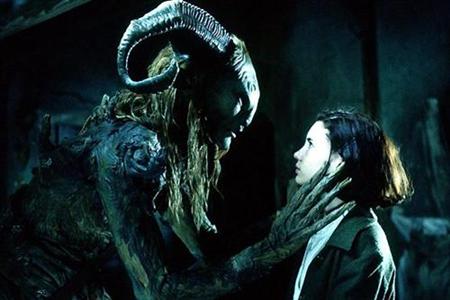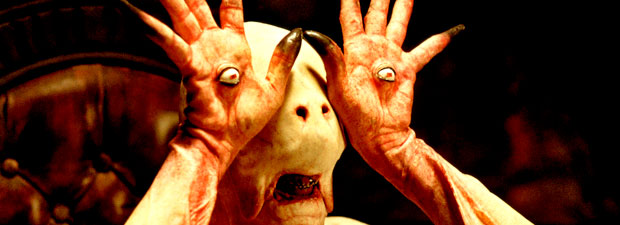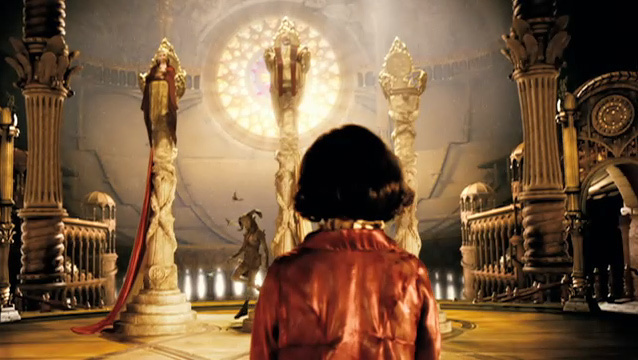Share This:
November 28, 2012 | Film,
The Beautifully Grotesque: Pan’s Labyrinth and LA BELLE ET LA Bête
When I first encountered Pan’s Labyrinth in 2007, my initial reaction was disgust. All I could remember after watching the film was a scene in which a frog essentially turns itself inside out (that’s a nice way of putting it), and I was wondering why such a nasty visual was deemed necessary by visionary director Guillermo del Toro. Yet, days later, my mind was still down the labyrinth, hanging out with that creepy monster with eyes in his hands. In a short amount of time, the grotesque first encounter turned into something beautiful, and I have since watched the film over and over, enjoying its unexpected layers of depth in addition to incredible imagination.
 It’s difficult to explain why Pan’s Labyrinth qualifies as a beautiful “fairy tale for grownups.” In reality, there is a lot of death, violence, and unsettling visual elements that contribute to the fabric of the film. The young Ofelia is the saving grace, as is the fact that del Toro is not shying away or dumbing down a story that could easily become a joke. By setting the whimsical adventure against the back-drop of war-torn Spain in 1944, del Toro challenges the audience to take a journey deep into child psychology or perhaps an alternate reality. Ofelia is drawn into the labyrinth by the mysterious faun-like creature Pan who gives her a quest that will ultimately save her and her mother from the authoritative hand of the evil stepfather. Of course, in this harsh world, things don’t turn out with a “happily ever after” per se, but Ofelia does at least find her way home.
It’s difficult to explain why Pan’s Labyrinth qualifies as a beautiful “fairy tale for grownups.” In reality, there is a lot of death, violence, and unsettling visual elements that contribute to the fabric of the film. The young Ofelia is the saving grace, as is the fact that del Toro is not shying away or dumbing down a story that could easily become a joke. By setting the whimsical adventure against the back-drop of war-torn Spain in 1944, del Toro challenges the audience to take a journey deep into child psychology or perhaps an alternate reality. Ofelia is drawn into the labyrinth by the mysterious faun-like creature Pan who gives her a quest that will ultimately save her and her mother from the authoritative hand of the evil stepfather. Of course, in this harsh world, things don’t turn out with a “happily ever after” per se, but Ofelia does at least find her way home.
More interesting, perhaps, is the way audiences and critics responded to the film: with overwhelming positive reviews and an almost cult following. The title began appearing on “Best of the Year” lists across the nation, and when awards season rolled out, Pan’s was competing for the highest honors. If someone had described the visual landscape to me, I would have thought these award people were crazy. After seeing it, I agreed: this is, somehow, against all odds, one of the more beautiful films to have crossed our way this past decade. But, inarguably, Pan’s Labyrinth does not fit into our traditional construct of beauty. It is a prime example of the Grotesque. Regardless, at the end of the film, I use the term “beauty” to describe it. Belle.
 I imagine this is what is at the core of the Beauty and the Beast story. It’s possible for things or people to visually look terrifying, when actually there is something contradictory beneath. Their form does not need to change; the film should not look different; it takes us adopting a new way of seeing, accepting an alternative definition of the Beautiful and the Grotesque. Even kind-hearted Belle was initially appalled by the Beast until she learned to see with new eyes.
I imagine this is what is at the core of the Beauty and the Beast story. It’s possible for things or people to visually look terrifying, when actually there is something contradictory beneath. Their form does not need to change; the film should not look different; it takes us adopting a new way of seeing, accepting an alternative definition of the Beautiful and the Grotesque. Even kind-hearted Belle was initially appalled by the Beast until she learned to see with new eyes.
With this spirit, I eagerly anticipate the arrival of La Belle et la Bête in Boston. Similar to del Toro, Lemieux Pilon 4D Art uses tantalizing visuals to transform our view of the Grotesque. I imagine there will be parts like the frog inverting itself—moments where I question why the demon is actually starting to scare me, or why this Beast looks significantly more frightening than the one Disney conjured up in my childhood. But it doesn’t stop there: that’s where this journey begins, a journey to develop new sight and new expectations for this Beauty. Where this journey ends is unpredictable, or maybe it will just be happily ever after.
Pan’s Labyrinth shows in ArtsEmerson’s Bright Family Screening Room on Friday, November 30 at 6pm, and Saturday, December 1 at 9pm.
La Belle et la Bête runs December 5-9 at the Culter Majestic Theatre.






Leave a Reply